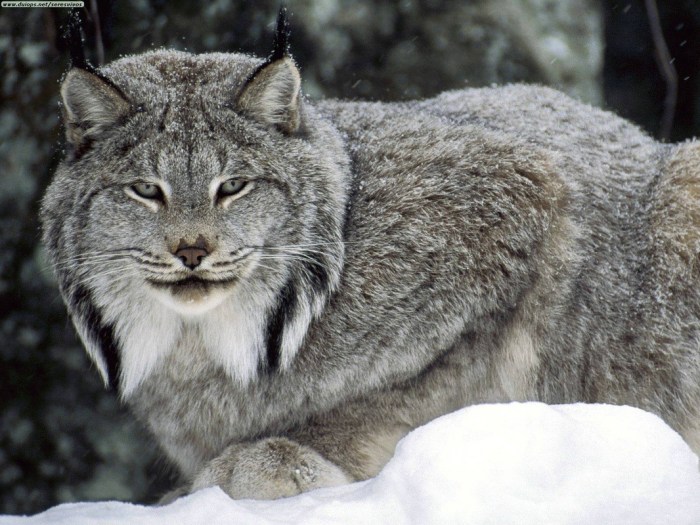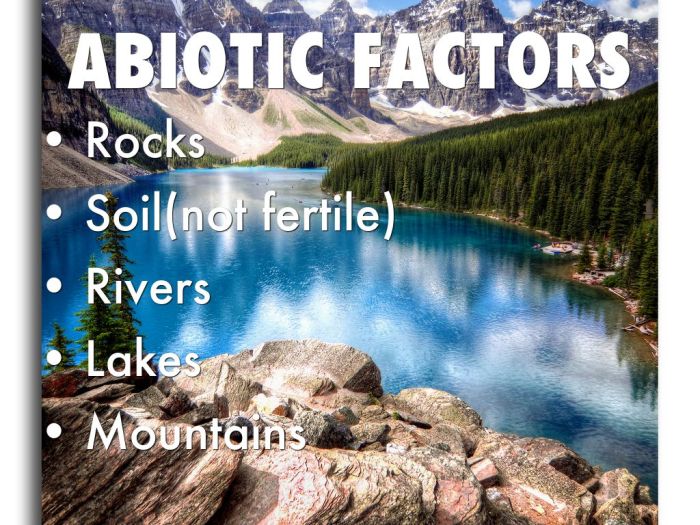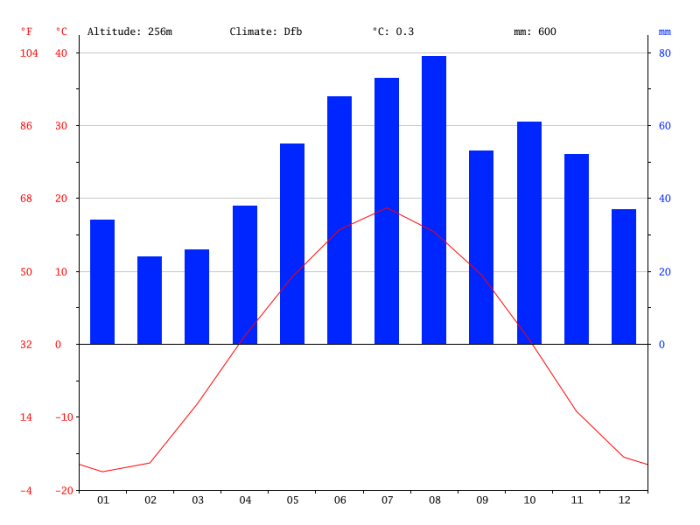Delving into the abiotic factors of a taiga, we embark on a journey into a realm of extreme temperatures, seasonal contrasts, and diverse landscapes. From the frigid winters to the brief but vibrant summers, the taiga’s abiotic environment plays a pivotal role in shaping the intricate tapestry of life within its icy embrace.
The average temperature in a taiga ranges from -5°C to 15°C, with extreme variations between seasons. During the long and harsh winters, temperatures can plummet to -40°C, while in the short but intense summers, they can soar to over 30°C.
These extreme temperature fluctuations impact the survival and adaptation of both plants and animals.
Temperature

Taiga regions experience a wide range of temperatures due to their location in high latitudes and continental interiors. The average temperature in a taiga varies significantly throughout the year, with cold winters and relatively warm summers.
Seasonal Variations
During winter, temperatures in the taiga can drop below -30°C (-22°F) in some areas. The extreme cold is caused by the lack of sunlight and the long nights. In contrast, summer temperatures can reach up to 20°C (68°F) in some areas, with long days providing ample sunlight for plant growth.
Effects on Plant and Animal Life
The extreme temperature fluctuations in the taiga have a significant impact on the plant and animal life in the region. Plants have adapted to the cold winters by developing thick bark and waxy leaves that help them retain heat. Animals, such as moose and wolves, have thick fur coats that insulate them from the cold.
Additionally, many animals migrate to warmer climates during the winter months to avoid the harsh conditions.
Precipitation

The taiga biome receives moderate to high levels of precipitation throughout the year, with an average annual rainfall ranging from 300 to 1,000 mm. Precipitation in the taiga occurs in various forms, including rain, snow, and sleet.
Forms of Precipitation
During the warmer months, precipitation primarily occurs as rain. As temperatures drop during autumn and winter, precipitation transitions to snow, which can accumulate significantly, forming a thick snowpack that covers the ground for several months.
Impact on the Ecosystem
Precipitation plays a crucial role in shaping the taiga ecosystem. Rainwater nourishes the vegetation, providing essential moisture for plant growth and productivity. The snowpack insulates the ground, protecting plants and animals from extreme cold during the harsh winter months. Additionally, the melting snow in spring provides a surge of water, which replenishes water bodies and supports the growth of new vegetation.
Sunlight

Sunlight is a crucial abiotic factor in the taiga ecosystem, influencing plant growth, animal behavior, and the overall functioning of the ecosystem.
The taiga experiences distinct seasonal variations in sunlight due to its high latitude location. During the long winter months, daylight hours are significantly reduced, with the sun remaining below the horizon for extended periods. This limited sunlight availability affects plant growth, as many species have adapted to survive with low light levels and extended periods of darkness.
Plant Growth
Sunlight is essential for photosynthesis, the process by which plants convert light energy into chemical energy. In the taiga, plants have evolved various adaptations to maximize sunlight absorption and utilization. Many species have broad leaves to capture more sunlight, while others have developed thick, waxy cuticles to reduce water loss during periods of low sunlight.
Animal Behavior
Sunlight also plays a significant role in animal behavior in the taiga. Many animals are active during the day, taking advantage of the available sunlight for hunting, foraging, and other activities. During the winter months, when sunlight is limited, some animals enter a state of hibernation or torpor to conserve energy.
Ecosystem Functioning
Sunlight is a primary driver of the taiga ecosystem. It influences temperature, precipitation patterns, and the availability of resources. The long days of summer allow for rapid plant growth and support a diverse array of animal species. In contrast, the short days of winter limit plant growth and reduce animal activity, leading to a more dormant ecosystem.
Soil
The soil in taigas is generally thin and acidic, with low nutrient content. The cold climate and slow decomposition rates result in the accumulation of organic matter on the forest floor, which can make the soil even more acidic. Despite these challenges, taiga soils do support a variety of plant life, including trees, shrubs, and mosses.
Nutrient Content
Taiga soils are generally low in nutrients, such as nitrogen, phosphorus, and potassium. This is due to the cold climate and slow decomposition rates, which limit the availability of nutrients for plants. However, some taiga soils do contain higher levels of nutrients, such as calcium and magnesium, which are released from the weathering of rocks.
Role in Plant Growth and Decomposition, Abiotic factors of a taiga
The soil in taigas plays an important role in plant growth and decomposition. The organic matter in the soil provides nutrients for plants, and the acidic conditions help to break down dead plant material. This process releases nutrients back into the soil, which can be used by other plants.
Water

Water is a crucial element for life in the taiga, providing hydration, shelter, and transportation for plants and animals. The taiga is characterized by a complex network of water bodies, including rivers, lakes, ponds, and wetlands.
The taiga’s abiotic factors, like temperature and precipitation, shape its ecosystem. If you’re curious about your health, consider taking the have I got lymphoma quiz . Returning to the taiga, its abiotic factors influence plant and animal life, creating a unique and dynamic environment.
Rivers and Streams
Rivers and streams are the lifeblood of the taiga, providing a vital source of water for plants and animals. They also serve as important transportation routes for fish and other aquatic creatures.
Lakes and Ponds
Lakes and ponds are important habitats for a variety of aquatic plants and animals. They provide a source of drinking water, food, and shelter for many species.
Wetlands
Wetlands are areas of land that are covered in water for at least part of the year. They are important habitats for a variety of plants and animals, including waterfowl, amphibians, and reptiles.
Importance of Water
Water is essential for the survival of all living organisms in the taiga. It is used for drinking, bathing, and irrigation. It also provides a habitat for a variety of plants and animals.
Human Impact on Water Resources
Human activities can have a negative impact on water resources in the taiga. These activities include pollution, deforestation, and climate change.
- Pollution:Pollution from industrial and agricultural activities can contaminate water sources and make them unsafe for drinking or bathing.
- Deforestation:Deforestation can lead to soil erosion, which can increase the amount of sediment in water bodies and make them less hospitable for aquatic life.
- Climate Change:Climate change is causing the taiga to become warmer and drier, which can lead to a decrease in the amount of water available for plants and animals.
Wind

The taiga experiences prevailing westerly winds, which originate from the west and blow towards the east. These winds are often strong and can reach speeds of up to 50 kilometers per hour. The wind patterns in the taiga are influenced by the Coriolis effect, which deflects winds to the right in the Northern Hemisphere.The
strong winds in the taiga can have a significant impact on vegetation and wildlife. The wind can cause trees to sway and bend, which can damage their branches and leaves. The wind can also cause snow to accumulate on the branches of trees, which can weigh them down and cause them to break.
The wind can also make it difficult for animals to move around, as they may be blown off course or have difficulty finding food.The wind plays an important role in seed dispersal and pollination in the taiga. The wind can carry seeds from one tree to another, which helps to ensure that the trees can reproduce.
The wind can also carry pollen from one flower to another, which helps to ensure that the flowers can produce fruit.
Effects on Vegetation
- Swaying and bending of trees, leading to branch and leaf damage.
- Accumulation of snow on tree branches, potentially causing breakage.
- Difficulty for trees to establish deep root systems due to strong winds.
Effects on Wildlife
- Impeded movement and navigation for animals due to strong wind gusts.
- Reduced visibility during snowstorms, affecting hunting and foraging activities.
- Potential hypothermia risk for small animals exposed to wind and cold temperatures.
Role in Seed Dispersal and Pollination
- Wind-borne seed dispersal, enabling trees to reproduce over long distances.
- Pollen carried by wind, facilitating cross-pollination and genetic diversity.
- Wind-dispersed seeds and pollen contribute to plant colonization and species distribution.
Fire: Abiotic Factors Of A Taiga
Fire plays a crucial role in shaping the taiga ecosystem. It is a natural disturbance that helps maintain the health and diversity of plant and animal communities.
Types of Fires
There are two main types of fires that occur in the taiga:
- Surface firesburn through the understory vegetation, including shrubs, grasses, and mosses.
- Crown firesburn through the canopy of trees, consuming leaves, branches, and even entire trees.
Crown fires are more severe and can cause significant damage to the forest. However, they are less common than surface fires.
Impact of Fire
Fire has a significant impact on plant and animal communities in the taiga. It can:
- Remove dead and decaying vegetation,which can reduce the risk of insect outbreaks and disease.
- Create openings in the forest canopy,which allows sunlight to reach the forest floor and promote the growth of new vegetation.
- Kill insects and other pests,which can help to control populations.
- Release nutrients into the soil,which can benefit plants and animals.
However, fire can also have negative impacts, such as:
- Destroying trees and other vegetation,which can reduce the amount of habitat available for wildlife.
- Releasing harmful pollutants into the air,which can affect human health and the environment.
- Increasing the risk of erosion,which can damage soil and water quality.
Overall, fire is a complex and important disturbance in the taiga ecosystem. It can have both positive and negative impacts, and its effects vary depending on the severity and frequency of the fire.
Commonly Asked Questions
What is the average annual precipitation in a taiga?
The average annual precipitation in a taiga ranges from 400 to 1000 mm, primarily in the form of snow during the winter months.
How does sunlight affect plant growth in a taiga?
During the short growing season, sunlight is a limiting factor for plant growth. Plants have adapted to maximize sunlight absorption through broad leaves and efficient photosynthetic pathways.
What is the role of fire in a taiga ecosystem?
Fire is a natural and essential disturbance in taiga ecosystems. It clears vegetation, releases nutrients, and creates diverse habitats for plant and animal species.